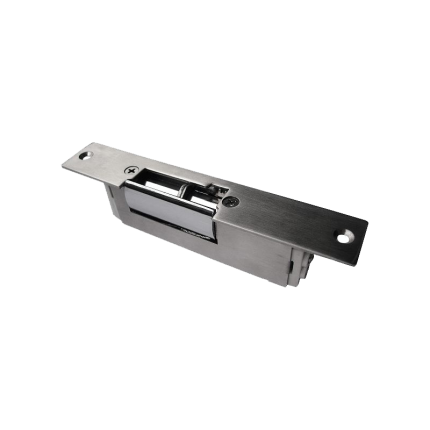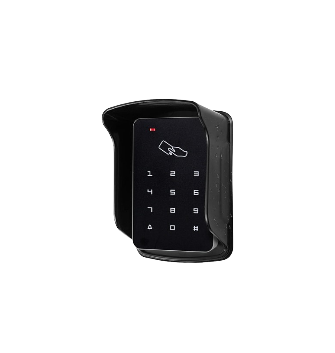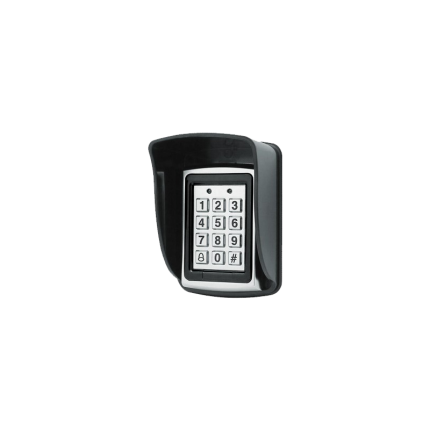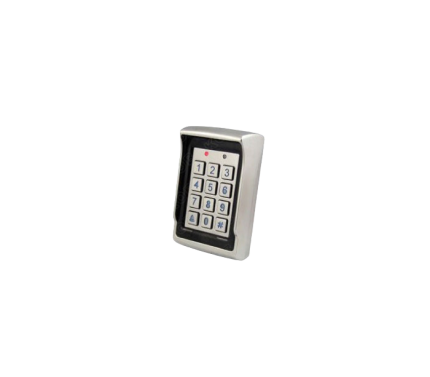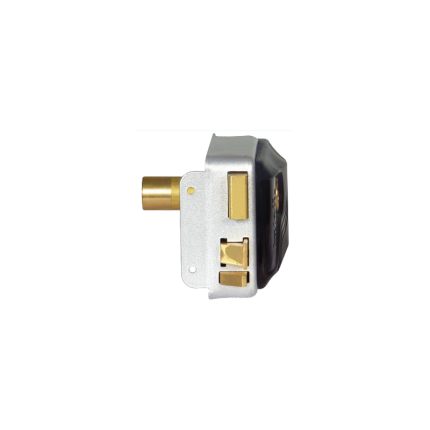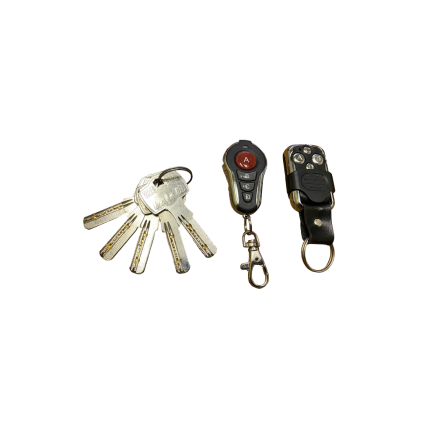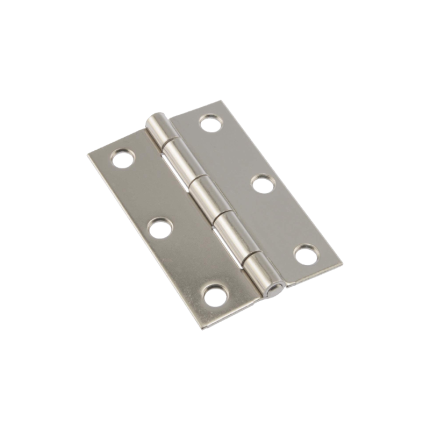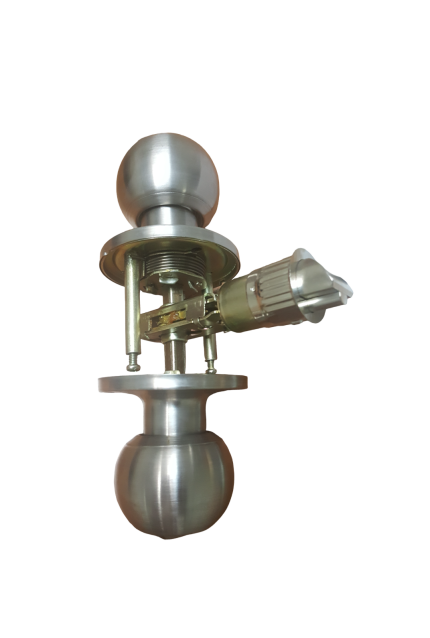pedestrian
Door Strike Lock
Ship or pick up from our office.
Door Strike Lock
*Fail-Secure/Fail-Safe *Capacity: 100 Kg *DC 12 VAn electric strike is an electromechanical lock release device that replaces a standard door strike plate.
It allows a door to be opened remotely, typically via an access control system, without manually retracting the latch. When activated, the electric strike releases the latch, enabling the door to be opened.
Here's a more detailed explanation:
Functionality:
-
Replaces Standard Strike:Electric strikes are installed in the door frame, taking the place of the standard strike plate.
-
Remote Release:They are designed to work with various access control systems, such as keypads, card readers, or intercoms.
-
Activation:When an authorized signal is received (e.g., a code is entered, a card is swiped), the electric strike releases the latch, allowing the door to be opened.
-
Fail-Safe or Fail-Secure:Electric strikes can be configured in either a fail-safe or fail-secure mode.
- Fail-safe: In this mode, the door unlocks when power is lost, making it suitable for safety applications where access is needed during power outages.
- Fail-secure: In this mode, the door remains locked when power is lost, requiring power to unlock, making it suitable for high-security applications.
How it Works:
- The electric strike contains a solenoid, which is an electromagnet.
- When the solenoid is activated by an electrical signal, it moves a component (like an armature) that allows the latch to move freely.
- This movement releases the door, allowing it to be opened.
Key Differences from Other Locks:
-
Electric vs. Magnetic Locks:Unlike magnetic locks, which use powerful magnets to hold the door closed, electric strikes release the latch mechanism.
-
Remote Access:Electric strikes offer remote access control, allowing doors to be unlocked without manual intervention.
-
Versatility:They can be used with various locking mechanisms, including cylindrical, mortise, and rim exit devices.
Common Applications:
-
Access Control:Electric strikes are a core component of access control systems in commercial and residential settings.
-
Security:They provide a higher level of security compared to standard locks, especially when used with fail-secure configurations.
-
Safety:In fail-safe configurations, they ensure safe egress during emergencies.
-
Specific Areas:They are commonly found in reception areas, daycare centers, and other locations where controlled access is needed.
Gate drop ground latch
Ship or pick up from our office.
Gate drop ground latch
A gate drop ground latch, also known as a cane bolt or drop rod, is a hardware mechanism used to secure a gate in either the open or closed position by inserting a rod into the ground.
It's commonly used for single or double gates, including wooden fences, metal gates, and even barn doors, to provide extra stability and prevent unwanted movement.
Here's a more detailed explanation:
How it works:
- The latch typically consists of a rod (the "drop rod" or "cane bolt") and a bracket or receiver that is mounted on the gate.
- When the gate is in the desired position (open or closed), the rod is manually lowered through the bracket and into a hole or receiver in the ground.
- This creates a secure hold, preventing the gate from swinging or being moved by wind or other forces.
- Some designs include a bracket or keeper to hold the rod in the raised (open) position when not in use.
Common uses:
- Securing single or double gates: The drop ground latch can be used on both types of gates to keep them firmly in place.
- Providing stability in windy conditions: It helps prevent gates from being blown open or closed by the wind.
- Securing gates in the open position: It can be used to hold a gate open, preventing it from accidentally closing.
- Reinforcing gate security: It adds an extra layer of security, making it more difficult to force the gate open.
- Suitable for various materials: Can be used with wood, metal, and other gate materials.
Benefits:
- Enhanced security: Prevents gates from being moved by wind or other forces.
- Increased stability: Helps keep gates aligned and prevents sagging.
- Versatile application: Can be used on a variety of gates and in different environments.
- Easy to operate: Simple manual operation to engage and disengage the latch.
- Relatively easy to install: Usually requires drilling holes for mounting the brackets.
Gate drop ground latch
Ship or pick up from our office.
Gate drop ground latch
A gate drop ground latch, also known as a cane bolt or drop rod, is a mechanism used to secure a gate in the open or closed position by inserting a rod into the ground.
It's typically used for double gates to keep one side stationary while the other is latched. It helps prevent gates from moving in the wind and adds extra security.
Here's a more detailed explanation:
How it works:
- A metal rod (the drop rod or cane bolt) is attached to the gate and slides through brackets or guides.
- When the gate is in the desired position (open or closed), the rod is lowered into a hole or receiver in the ground, securing the gate.
- To open the gate, the rod is lifted out of the ground and turned out of the way.
Key features and benefits:
- Secures gates: Prevents gates from swinging open or closed due to wind or other factors.
- Versatile: Can be used on various gate types, including wood, metal, and vinyl.
- Double gate support: Especially useful for securing one side of a double gate while the other is latched.
- Added security: Can be used in conjunction with other latches for increased security.
- Easy installation: Generally involves mounting brackets and drilling a hole for the rod.
- Durable: Made of materials like steel, often with a powder coat finish for weather resistance.
Keypad Access Control K110V2000
Keypad Access Control K110V2000
*Waterproof Version *EM - RFID card/tag reader *Finger Touch *Backlight *DC 12 V *1000 Users *Doorbell button *Rain Shield Cover IncludedThe Keypad Access Control K110V2000 is a standalone access control system designed for single-door access, typically used for residential or small-to-medium commercial buildings.
It allows users to unlock the door using either a proximity card, a PIN code, or a combination of both.
Here's a more detailed breakdown:
Key Features:
- Multiple User Capacity: It can support up to 1000 users.
- Multiple Access Methods: Users can unlock the door using RFID cards, PIN codes, or both.
- Standalone Operation: It functions independently, without needing to be connected to a central computer.
- Wiegand Input/Output: It can connect to an external card reader (Wiegand 26 input) and a controller (Wiegand 26 output).
- Tamper Alarm: Includes a tamper alarm for added security.
- Backlit Keypad: The keypad is backlit, making it easier to use in low-light conditions.
- Short Circuit Protection: The output is automatically turned off if there's a short circuit in the electric lock or alarm output.
- Waterproof: Some models, like the V2000-C, are waterproof, making them suitable for outdoor use.
- Easy Installation and Programming: The system is designed for straightforward installation and programming.
- Doorbell Input: Some models include a doorbell input.
- Adjustable Settings: Features like door output time, alarm time, and door open time can be adjusted.
Applications:
- Residential Buildings: Ideal for controlling access to apartments or individual homes.
- Small to Medium Businesses: Suitable for offices, shops, and other commercial spaces.
- Warehouses and Factories: Can be used to manage access to secure areas.
- Other Applications: Laboratories, banks, and even prisons.
Keypad Access Control K170S300A
Keypad Access Control K170S300A
*Rain Shield Cover Included *Waterproof Version *EM/ID card/tag reader *Backlight *DC 12 V *Shock resistance *Anti-vandal Metal shell *Doorbell Button Wiegand Output: Equipped with a Wiegand output for seamless integration with a controller. Multiple Access Modes: Offers Card, PIN, or Card + PIN options, providing versatile access control methods. Durable Metal Case: Housed in a robust Zinc Alloy electroplated case, ensuring durability and vandal resistance. RFID Key Fob Duplicator Attribute-Based Access Control Vs Role-Based Access Control 1,000 User Capacity: Supports up to 1,000 users, ideal for large-scale access control in commercial and industrial settings. Backlight Keypad: Features a backlight keypad for easy operation in low-light conditions.Description
1000 Users Metal Case 125KHZ RFID Card Keypad Access Controller with Backlight Door Control Independent Code Access Device
Description
Single door multifunction standalone access controller or a Wiegand output keypad or card reader.
It is suitable for mounting either indoor or outdoor in harsh environments.
It is housed in a strong, sturdy and vandal proof Zinc Alloy electroplated case which is availabl in either a bright silver or matt silver finish.
Metal Case&Waterproof .Supports up to 1000 users in either a Card, 4 digit PIN, or a Card + PIN option.
The inbuilt card reader supports125KHZ EM cardsLock output current short circuit protection, Wiegand output , and a backlight keypad.
Ideal choice for door access not only for small shops and domestic households but als for commercial and industrial applications such as factories, warehouses, laboratories, banks and prisons.
Features
Simple Programming, Easy Operatio
Adopt function steady card reader of block
Keypad Locks for 30 Seconds After 10 False Entrie
Can be Connected with Door-open Button and Doorbel
Non-volatile Memory in Power Failure
Tamper Switch can be Connected to Security Alarm System
Backlight key
Wiegand 26 output for connection to a controller
Support 1000Users
Pedestrian gate electric lock
Ship or pick up from our office.
Pedestrian gate electric lock
*DC12 V A pedestrian gate electric lock is a device that uses electrical power to secure a walk-through gate, offering enhanced security and convenience compared to traditional manual locks. These locks are commonly used in residential, commercial, and community settings, often integrated with access control systems. Here's a breakdown of what they are and how they work: How they work:- Electronic Control: The locking mechanism is controlled electronically. This allows it to be locked and unlocked automatically, typically triggered by an access control system.
- Access Control Integration: They can be linked to various access control devices, such as:
- Keypads: Users enter a code to unlock the gate.
- Remote controls: Wireless remotes allow for convenient opening from a distance.
- Intercoms: Visitors can communicate with occupants, who can then grant access.
- Key fobs/Card readers: Users can simply tap or swipe a fob/card to unlock.
- Push buttons: For easy exit from the inside.
- Telephone entry systems: Allowing access via phone.
- Types of Electric Locks:
- Electromechanical Locks: These use an electric impulse to trigger a mechanical latch or bolt to engage or disengage. They are known for their strength and durability, suitable for both indoor and outdoor use.
- Electromagnetic Locks (Maglocks): These consist of an electromagnet mounted on the gate frame and a strike plate on the gate itself. When power is applied, the electromagnet creates a strong magnetic force that holds the gate closed. To unlock, the power to the magnet is simply cut. They offer a high holding force and have no moving parts to wear out.
- Enhanced Security: They provide a higher level of security than manual locks, preventing forced entry and ensuring the gate remains closed, especially in high-wind conditions.
- Automatic Locking/Unlocking: Many models automatically lock when the gate closes and unlock when activated, eliminating the need for manual locking.
- Convenience: Remote operation, keypads, and other access control options make entry and exit much more convenient.
- Versatile Applications: Suitable for a variety of pedestrian gate types (wood, steel, vinyl, etc.) and environments, including driveways, pool areas, playgrounds, and commercial perimeters.
- Fail-Secure vs. Fail-Safe:
- Fail-Secure: The lock remains locked when power is lost. This is common for high-security applications where maintaining security during a power outage is crucial.
- Fail-Safe: The lock unlocks when power is lost. This is often used in safety applications where immediate access is needed during emergencies or power failures.
- Battery Backup: Many systems include a battery backup to ensure continued operation during power outages.
- Manual Override: Most electric locks come with a key for manual release, providing a backup in case of power failure or system malfunction.
- Integration: They can be easily integrated with existing gate openers, timers, and other smart home or security systems.
Pedestrian gate electric lock with remote control
Ship or pick up from our office.
Pedestrian gate electric lock with remote control
* Two remote controls included *DC 12 V pedestrian gate electric lock with a remote control is a security system that allows you to lock and unlock a walk-through gate using an electrical mechanism, typically activated by a remote control. This provides convenience and enhanced security, as you don't need a physical key to open the gate. Here's a breakdown of what it entails: How it Works:- Electric Lock Mechanism: Instead of a traditional manual deadbolt or latch, an electric lock uses an electrical impulse to control a bolt or latch. This impulse can come from a control board connected to various access control devices.
- Remote Control Activation: A key component is the remote control, which sends a wireless signal (radio frequency) to a receiver connected to the lock's control system. When the signal is received and recognized, the lock is instructed to engage (lock) or disengage (unlock).
- Integration with Gate Systems: These locks are often integrated with automatic gate openers or access control systems. When the gate closes, the lock can automatically engage, and when a remote signal is given, it disengages to allow the gate to open.
- Power Source: Electric locks require a power source, typically low voltage (e.g., 12V DC). Many systems include a battery backup to ensure continued operation during power outages.
- Solenoid Locks: These use an electromagnet to extend or retract a bolt, securing or releasing the gate.
- Electromagnetic Locks (Mag Locks): These consist of an electromagnet mounted on the gate frame and a metal strike plate on the gate itself. When power is applied, the electromagnet creates a powerful magnetic force that holds the gate shut. Removing power releases the lock.
- Electric Strikes: These replace the standard strike plate on the gate frame. They contain a solenoid that, when activated, pivots or retracts to release the gate's latch. They are often combined with a traditional keyed doorknob or lever.
- Remote Operation: The primary benefit, allowing you to open or close the gate from a distance.
- Automatic Operation: Many models automatically lock when the gate closes, improving security.
- Fail-Safe vs. Fail-Secure:
- Fail-Secure: The lock remains locked when power is lost. This is common for high-security applications where you want the gate to stay secure even during a power outage.
- Fail-Safe: The lock unlocks when power is lost. This might be preferred for safety reasons, ensuring an exit path in an emergency.
- Holding Force: This indicates the strength of the lock in resisting forced entry, measured in pounds (lbs).
- Compatibility: Ensure the electric lock is compatible with your specific gate type (wood, metal, swing, etc.) and any existing or planned access control systems (keypads, intercoms, smart home systems).
- Manual Override: Many electric locks include a manual release key or mechanism for use in case of power failure or remote control malfunction.
- Durability and Weather Resistance: Given that they are outdoors, look for locks built with durable, weather-resistant materials.
- Integration with Other Access Control: Beyond remote controls, these locks can often be integrated with:
- Keypads (for code entry)
- Intercom systems (audio/video communication and remote release)
- Smartphone apps (for remote monitoring and control)
- Biometric readers (fingerprint, face scan)
Pedestrian Gate Hinges
Ship or pick up from our office.
Pedestrian Gate Hinges
Pedestrian gate hinges are designed to allow a gate intended for pedestrian use to swing open and closed, connecting the gate to its post or frame.
These hinges are crucial for the smooth operation and secure closure of the gate, ensuring proper alignment and functionality. They can be surface-mounted, bolt-on, or weld-on, and may include features like spring-assist or adjustable tension for self-closing.
Here's a more detailed breakdown:
-
Function:Pedestrian gate hinges primarily serve to join the gate to its supporting structure (post or frame) and allow for rotation.
-
Types:They can be surface-mounted, bolt-on, or weld-on, offering different installation methods.
-
Features:Some hinges incorporate self-closing mechanisms, like spring-assist or adjustable tension, which can be important for safety or convenience.
-
Materials:They are commonly made from steel, stainless steel, or polymer, ensuring durability and resistance to the elements.
-
Applications:Pedestrian gate hinges are suitable for various settings, including residential, HOA, and commercial properties, especially for side gates, walkways, and restricted access enclosures.
-
Considerations:When choosing hinges, factors like the gate's weight, size, and desired functionality (e.g., self-closing) should be taken into account.
Pedestrian gate manual lock (One side key)
Ship or pick up from our office.
Pedestrian gate manual lock (One side key)
A "pedestrian gate manual lock (one side key)" refers to a type of locking mechanism for a gate that is operated manually and requires a key to unlock it from one side, while the other side allows for easy exit without a key. Here's a breakdown of its key features:- Manual Operation: This lock doesn't rely on electricity or automation. You physically use your hand to engage or disengage the locking mechanism.
- One-Sided Key Access: The defining characteristic is that a physical key is needed to unlock the gate from one specific side (usually the exterior or entry side).
- Easy Exit (Thumb-Turn, Latch, or Push Pad): On the interior or exit side, there's typically a simple mechanism like a thumb-turn, lever, push pad, or a basic latch that allows for quick and easy opening without needing a key. This is often a safety feature, especially for emergency exits.
- Security: It provides a basic level of security, preventing unauthorized entry from the keyed side.
- Power Independence: Since it's manual, it's not affected by power outages.
- Common Use Cases: These locks are frequently found on garden gates, backyard gates, pool gates, and other pedestrian access points where controlled entry is desired but a quick exit is also necessary.
Pedestrian gate manual lock (Two-sided key)
Ship or pick up from our office.
Pedestrian gate manual lock (Two-sided key)
A "pedestrian gate manual lock (two-sided key)" refers to a type of gate latch or lock that can be operated and secured with a key from both sides of the gate. Here's a breakdown of what that means and why it's useful:- Manual Lock: This indicates that the lock is operated by hand, typically by turning a key or a knob/lever, rather than being electric or automated.
- Two-Sided Key (or Keyed on Both Sides): This is the key feature. It means that there is a key cylinder on both the exterior and interior sides of the gate. This allows you to:
- Lock the gate from either the inside or the outside using a key.
- Unlock the gate from either the inside or the outside using a key.
- Convenience: You don't have to walk around the gate to unlock it if you're on the "wrong" side.
- Security: It provides a consistent level of security from both directions, preventing unauthorized access whether someone is trying to get in from the outside or out from the inside (if that's a concern).
- Accessibility: It can be crucial for pedestrian gates that serve as primary entry points, offering easy access for residents or authorized personnel from either side.
- Deadbolt Hook Locks: These use a hook-shaped bolt that engages with a strike plate on the gate post.
- Mortise Locks: These are installed within a pocket cut into the gate frame, offering a clean, flush appearance and good security.
- Rim Locks: These are surface-mounted on the gate, making them easier to install.
- Latches with an external access kit: Some general-purpose gate latches can be converted to be two-sided key-lockable with an additional kit.

